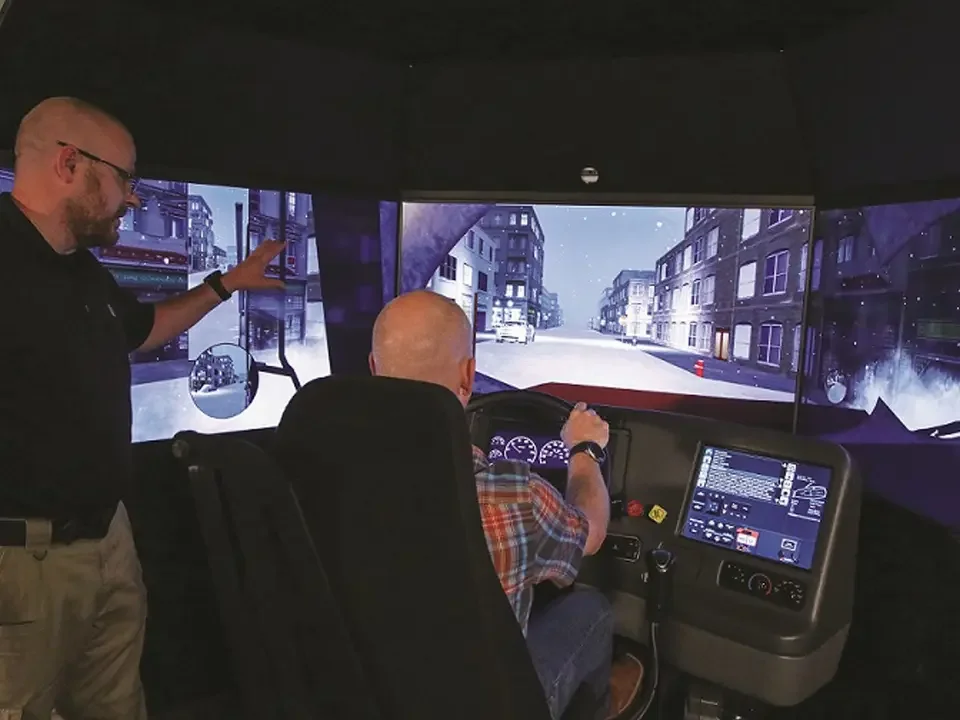Virtual truck driving simulators have emerged as an exciting training method for both young and experienced truckers.
Simulators use realistic and highly adaptable technologies to enable drivers to improve their skills in a range of scenarios, preparing them for the trucker profession. This technology could be vital in helping with current industry difficulties, such as the trucker shortage.
I spoke to leading simulator providers to outline how these simulators work, and how they are helping the current issues facing the logistics industry. I also outline the benefits of the technology, to help you decide if it is a potential pathway for your business.
Key Takeaways
- Virtual truck driving simulators allow trainees to practice in hazardous conditions, such as adverse weather or emergency scenarios, without any real-world danger.
- Simulator training is highly adaptable, enabling instructors to create personalized scenarios that target a driver’s specific weaknesses for focused skill improvement.
- Adopting simulator training significantly reduces operational expenses by saving on fuel, minimizing vehicle wear-and-tear, and lowering costs related to accidents.
- Training programs can be easily scaled and updated with simple software inputs to reflect different vehicle types or new road challenges.
What Are Virtual Truck Driving Simulators, and How Do They Work?
Virtual truck driving simulators are a technology that replicate the experience of driving a truck, to allow users to practice their skills in a controlled environment.
Acron Aviation have been designing and building driving simulators for 34 years. Tyler Holzer, Vice President & General Manager, explained to me how its simulators work for truckers:
“The trainer or student selects a scenario or creates a custom scenario tailored to the driver’s training needs. The driver starts the scenario and navigates through the virtual environment, encountering various driving challenges. During the simulation, the system provides real-time feedback, such as alerts for traffic violations or unsafe driving behaviors.”
Essentially, the simulators work much like you would expect a traditional trucking or driving game to work. However, they also include highly realistic hardware, giving drivers the experience of actually being inside the vehicle.
When I asked about Ansible Motion‘s simulators, Technical Director Elliot Dason-Barber explained how hardware is designed so that “test drivers can sit in the correct position with proper steering, dash, pedals and mirrors – just as they would in a real vehicle.”
Ansible’s setup also includes a rear-view mirror system for trucks “designed to deliver visual content relative to the true vehicle position”. Likewise, drivers are also “informed by natural audio feeds that convey sounds like tire and engine noise”, creating an immersive experience that prepares them for real world driving.
How Are Virtual Truck Driving Simulators Helping the Trucking Industry?
Trucking simulators are helping to address the limitations of traditional driver training and the ongoing issues in the trucking industry, such as increasing costs, the driver shortage, and introducing more sustainable practices.
According to Tech.co’s 2025 Logistics Report, 45% of logistics businesses say a lack of qualified applicants is the biggest challenge in maintaining a steady driver workforce, and 63% of respondents say their ability to recruit and retain drivers has either stagnated or worsened over the past year.
Driving simulators give potential drivers the opportunity to be trained in real-world conditions, without the risk. Holzer explains how simulators “provide a safe environment for drivers to learn in difficult scenarios without the risk of real-world consequences” improving the “confidence” and “decision-making skills under pressure” of the next generation of drivers.

Acron Aviation’s simulator-based training. Image: Acron Aviation
These skills are incredibly important, particularly as trucking is consistently listed as one of the most dangerous professions. According to Payal Gupta, co-founder at Tecknotrove, simulators “have proved to save up to 40% of potential accidents across industries.”
Likewise, well-trained drivers means fewer accidents, which in turn means less spent on repairs. Facing ongoing tariffs and regulatory changes, trucking businesses will be looking to save where they can. Through simulators, drivers can make the mistakes they need to as part of the learning process.
To read more about how technology is helping the logistics industry, read our article on warehouse automation.
Benefits of Virtual Truck Driving Simulators For Your Business
Some of the potential positives of incorporating virtual truck driving simulators into your business include:
Improved Safety
Driving simulators give trainee drivers the opportunity to make mistakes without potentially life-altering consequences. Holzer points out their ability to expose “drivers to dangerous driving conditions, while maintaining safety”, an opportunity that is invaluable to the learner driver and will no doubt improve their skills.
While Dason-Barber believes simulators can’t replace the experience of real-world driving, he believes their malleability to be essential for a new driver: “a learner truck driver can repeatedly train with different vehicle types, varying road conditions and routes, cargo variations, weather situations or navigate hazards and emergency scenarios”.
All of these experiences will contribute to training drivers that are more confident and safer behind the wheel.
Enhanced and Personalized Training
With simulations, drivers and trainers can actively review performances, and build progress based on personalized goals. Holzer explains how the driver is able to “repeat scenarios to practice specific skills and track progress over time”, which allows trainees to be consistently working on and improving their weaknesses.
“Instructors can also pause or repeat parts of a simulator training session, pointing to details such as measured data and video replays, to help drivers understand what went well and help drivers learn what could be improved upon”, Dason-Barber says. This type of one-on-one training and in-depth insight assures that drivers are consistently improving their skills.
Holzer suggests too that simulators could also help trainers and established drivers brush up on their own skills. “Training sessions are only as good as the trainers, so our courses include a Train-the-Trainer certification course.”

Cost Savings
Holzer claims that “an effective simulation-based training program is the most cost-effective training option”, mostly due to the savings businesses can unlock by substituting real vehicles for simulations. These savings include “fuel, vehicle wear-and-tear, training costs, and safety incidents.”
Similarly, Dason-Barber added that businesses can use simulations to find out what is working in their trucks, and what isn’t: “potential problems can be caught early in the vehicle development cycle, long before they become expensive-to-correct design or retooling issues.”
This could be beneficial for businesses looking to test out or try new functions within their vehicles, without the risks that a real-life setting could bring.
Scalability
Simulators can be easily scaled, up or down, as needed by different companies. This is helped by the fact that they are easily customizable, allowing them to suit the needs of each driver.
And, as Dason-Barber states, these changes can be “made at lightning speed – with computer keystrokes instead of wrenches.” Likewise, Dason-Barber explains, “changing between wildly different vehicle types just means switching a cabin – which takes about thirty minutes – and a vehicle physics model – which takes less than five.”
Therefore, driving simulators can be seen as highly efficient, saving operators and drivers’ time.
What Is the Future of Virtual Truck Driving Simulators?
According to a 2025 Tech.co Logistics Report, 21% of professionals expect the driver shortage to worsen. With driving simulators becoming an increasingly attractive way for companies to train new drivers, experts predict that the technology will only continue to grow.
“The potential for driver training, product improvement and significant savings in development costs is simply too great to ignore” – Elliot Dason-Barber, Technical Director at Ansible Motion
Likewise, companies are expecting that the US will begin to look at simulator training as a key foothold in trucker training, following the trends of countries such as Germany, allowing “for driving simulator-based training to count toward a portion of the mandatory behind-the-wheel training for a commercial driver’s license,” Holzer suggests.
Both Holzer and Dason-Barber agree that the future of the technology is exciting, and new developments are certainly in the pipeline for their companies. Acron Aviation, for instance, released its first simulators that can be driven with a virtual reality headset in June.
With their numerous benefits, driving simulators could be a strong possibility for many logistics businesses. They are highly scalable and personalized, and have proven safety and cost benefits. If your business is looking to save time and resources when training drivers, it’s definitely a technology to look into.
